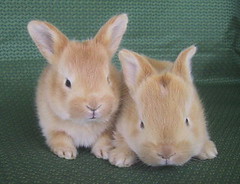It’s hard to believe that spring will be upon us in a few months! We pretty much missed winter this year in
So far, one of the most important tools I’ve used in advertising my rabbits is our website (www.geocities.com/cremerabbits). I may actually be a little too dependent on it, but it can be such an effective tool! Websites are usually quite inexpensive, and they allow you to have information available to potential bunny customers 24/7. If you use a so-called “free” (supported by banner ads on your site) website hosting service like Geocities or FreeWebs you can get started very cheaply indeed!
Another valuable tool in advertising is online classified sites. Placing an ad online is faster than updating a website. You can also use classified ads to encourage people to visit your website. ("Want to see pictures of my adorable English Angora babies? Visit my website!")
I feel that classified websites like these are especially important in reaching the general (read: non-breeder) public. They get a lot of traffic, and they’re probably one of the first websites someone will visit when they’re looking for a new pet. Thus, having regular ads running can be very helpful in drawing new customers!
When you write a classified ad, be specific about what you have for sale and try to narrow down your location (I'd strongly advise you not to post your actual address online, but it doesn't hurt to say that you're half an hour north of Chicago.). Think about some of the key words people might use to find rabbits like yours - use those words in your ad! Here's an example:We have an adorable litter of Holland Lop bunny rabbits for sale or adoption. Parents are ARBA registered Grand Champions. Hollands are sweet, friendly dwarf rabbits. The bunnies are well-socialized, and would make great pets, 4-H projects, or show prospects. Visit our website at www.yourname.com for pictures and more information! $35.00
Having photographs of the rabbits you're trying to sell is invaluable when using online classifieds. PetClassifieds.us, a popular free classifieds site, said that ads on their site with pictures get four times as many responses as ads without! This goes without saying, but make sure the picture is clear and flatters your rabbits. [grin] Try to get pictures that capture the "personality" of your rabbits, not simply a static posed shot.
Here's a few of my favorite classifieds sites:
Network
And last, but not least: join a few rabbit-related forums and message boards. There's a myriad of them on Yahoo Groups, plus independent boards like the rabbit forum on HomesteadingToday. You do want to be polite and avoid posting a lot of unwanted ads on a forum, but it can still be a good place for hobbyists to advertise. (Make sure your board allows ads before you post, by the way.) One of the advantages of advertising on a forum you visit regularily is that people can get to "know" you a little. Some people are more comfortable with that. How many responses you get will vary with the board.
When you post an ad on a forum, I'd avoid the "hard sell" type ad - write your sales post in a friendly, personable tone. (Forums are where people go to have fun, after all. While they may be interested in what you have to sell, they don't want to be bombarded with "advertising".)
Here's an example:
Anyhow, I hope this post has given you some ideas for advertising. Feel free to drop me a line and share your own tips and ideas! I'm always looking for new stuff for the blog.
